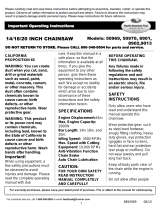
3
2 CONTENTS
2.1 CONTENTS
PAGE CONTENT PAGE
1 TITLE PAGE
1.1 INTRODUCTION ..................................................................................................................2
1.2 REVISION HISTORY..............................................................................................................2
1.3 UNDERSTANDING THIS MANUAL ......................................................................................2
1.4 COPYRIGHT NOTICE ............................................................................................................2
2 CONTENTS
2.1 CONTENTS ...........................................................................................................................3
3 GUARANTEE
3.1 GUARANTEE ........................................................................................................................4
4 INTRODUCTION
4.1 SCOPE ..................................................................................................................................5
4.2 SPECIFICATION ....................................................................................................................5
4.3 HANDLING & STORAGE ......................................................................................................6
5 HEALTH & SAFETY INFORMATION
5.1 SAFETY INSTRUCTIONS FOR CHAINSAW USE ....................................................................7
5.2 HEALTH AND SAFETY INFORMATION CONCERNING THE USE OF FUELS ......................11
6 TECHNICAL DESCRIPTION
6.1 IDENTIFICATION ................................................................................................................12
7 UNPACKING & CHECKING
7.1 PACKAGING.......................................................................................................................14
7.2 WHAT’S IN THE BOX .........................................................................................................14
8 ASSEMBLY
8.1 ATTACHING/ADJUSTING GUIDE BAR AND CHAIN ..........................................................15
8.2 FUEL AND LUBRICATION ..................................................................................................18
9 OPERATION & USE
9.1 COLD STARTING THE ENGINE........................................................................................... 19
9.2 WARM STARTING THE ENGINE ........................................................................................20
9.3 STOPPING THE ENGINE .....................................................................................................20
9.4 PERSONAL PROTECTIVE EQUIPMENT (PPE) .....................................................................20
9.5 HOLDING THE CHAINSAW................................................................................................ 21
9.6 KICKBACK .......................................................................................................................... 22
9.7 CHAIN BRAKE ....................................................................................................................23
9.8 CUTTING ............................................................................................................................23
9.9 FELLING..............................................................................................................................23
9.10 DELIMBING ........................................................................................................................24
9.11 CROSS CUTTING/BUCKING ................................................................................................25
9.12 SAW CHAIN .......................................................................................................................25
9.13 CHAIN LUBRICATION ........................................................................................................26
9.14 SHARPENING .....................................................................................................................26
10 MAINTENANCE
10.1 CARBURETTOR ADJUSTMENT ..........................................................................................27
10.2 BAR MAINTENANCE..........................................................................................................27
10.3 AIR FILTER..........................................................................................................................28
10.4 FUEL FILTER .......................................................................................................................28
10.5 OIL FILTER .......................................................................................................................... 28
10.6 SPARK PLUG ......................................................................................................................29
10.7 CLEANING, TRANSPORT AND STORAGE ..........................................................................29
11 TROUBLESHOOTING
11.1 TROUBLESHOOTING GUIDE .............................................................................................30
12 EXPLANATION OF SYMBOLS
12.1 EXPLANATION OF SYMBOLS ...........................................................................................33
13 DISPOSAL
13.1 DISPOSAL ..........................................................................................................................34
DECLARATION OF CONFORMITY ....................................................................................................... ENCLOSED























